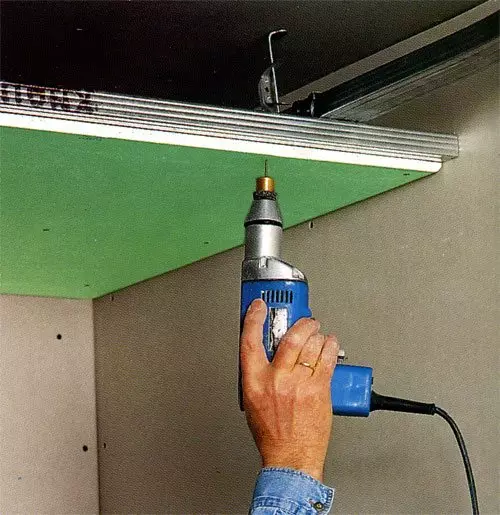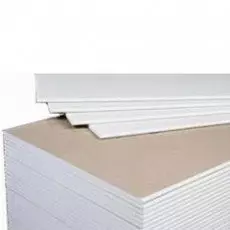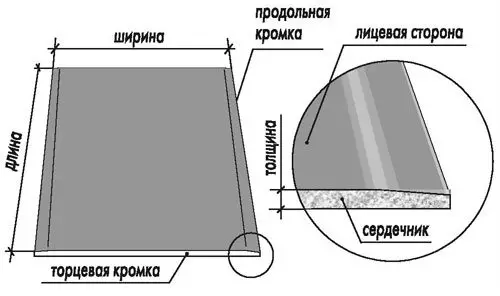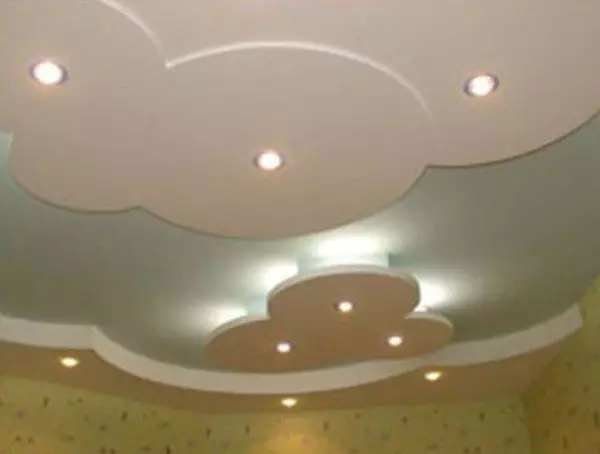To date, plasterboard is one of the most common materials for creating ceilings. It is pretty simple and flexible in work, providing the designer a large field for activity. The ceilings made of drywall are as "flat", that is, having a classic look and multi-level, which distinguish the original forms, the presence of hidden illumination and any decorative sizes.

Installation of ceiling plasterboard.
With all the design capabilities, plasterboard ceilings have a lot of technical advantages, which is also their important advantage. Therefore, the popularity of this material is due to a number of important aspects and features, many of which are obvious. Thus, the strength, reliability and durability of drywall, as well as huge space for bold design solutions, were evaluated by many professionals from around the world.
Plasterboard - new generation material
Plasterboard - the material is quite not new in the construction market. Its structure is extremely simple: the layer of plaster is covered with thin, but sturdy cardboard sheets. Very popular ceiling trim plasterboard.This allows the material to be strong and convenient to work. In addition to ceiling coats, drywall are actively used as interior partitions. However, the size of the ceiling drywall is somewhat different from the material of another destination.
Since plasterboard is an excellent replacement of plaster and has a fairly wide range of applications, the dimensions of its sheets depends on the scope of its use.
Dimensions of sheets of plasterboard
The finishing of surfaces during repair work provides for various types of plasterboard, the difference between which exists only in terms of the size of the sheet. So, if you have a task to separate the ceiling, then you should understand the size of the ceiling drywall, in order to prevent errors in the acquisition, the material is necessary and in the subsequent mounting of the plasterboard mounted ceiling.
Article on the topic: Using a curtain instead of doors
Naturally, many decide that it is easiest to contact the seller in a construction store, however, the famous saying "trust, but check" today it becomes particularly serious sense. Sellers are exhibited their norms and plans, and therefore they most often need to sell what is at the moment, therefore, to understand the acquired goods on its own today more than appropriate.

Ceiling plasterboard.
Sheets of plasterboard are:
- All kinds of GLCs in the width reach 1.2 m. The dimensions of the plasterboard ceiling in this case are no exception.
- The length of the sheets varies in the range of 2-3.6 m.
- The thickness of the plasterboard sheets, depending on the species, can be from 6.5 to 12.5 mm.
It is possible to determine the type of plasterboard sheet only by dimensions, since other differences simply do not exist. All types of drywall have the same structure and appearance. Therefore, if you want to make the right choice, then the following recommendations must remember.
Differences between drywall sheets of different types
- Arched plasterboard is the thinnest . This is due to the specifics of the work carried out using this material. Its thickness is only 6.5 mm, which makes it easy to breast on almost any radii.
- If the sheet is in a width of 12.5 mm - then it is a wall plasterboard. Such dimensions are considered an optimal option not only for alignment of walls, but also to create interroom partitions, as well as various structures, including niches that should have a certain rigidity.

List scheme made of drywall.
- Ceiling plasterboard The dimensions of which vary in the range of 8-9.5 mm is a lightweight version of the sheets of standard type. A smaller width reduces the total mass of the suspended ceiling, while maintaining its strength and reliability. In addition, the reduction in thickness and mass leads to a tangible savings of the number of profile, because the reduction of the weight of the sheath allows you to increase the step between the planks.
Article on the topic: Embroidery with a cross scheme: in a hat man and woman, sets in red, with jug and cycling, with umbrella
Thus, the design is solid and easy, which is the optimal option for the suspension ceiling.
Tip! Before buying a material, be calculated, creating a drawing of the future coating, especially if we are talking about a multi-level structure. This will save you and money, and time.
Articles on the topic:
- Ceiling mall thickness thickness
- What kind of plasterboard is better to use for the ceiling
- Dimensions of drywall Knauff
Classification of ceiling plasterboard
Depending on the terms of use, the size of the ceiling plasterboard may be different.
- Standard ceiling plasterboard . It is used when finishing the room with a normal level of humidity. It is characterized by a minimum thickness, which varies from various manufacturers from 8 to 9.5 mm.
- Plasterboard moisture resistant . For ceilings with a reduced level of moisture absorption, special coating is not provided. However, a number of manufacturers will offer you in this case more subtle variants of ordinary moisture-resistant materials. Such sheets are commonly used when finishing rooms with high humidity (kitchen, bathroom).
- Fire resistant plasterboard plates . They are universal, and in this case, it is recommended to choose plasterboard ceiling - the dimensions of which do not exceed 9 mm in the thickness.

Multi-level ceiling of plasterboard.
Conclusion
Due to the high popularity of drywall, many want to install such ceilings on their own. And at least at first glance it may seem that the creation of such structures is quite complex volumes of work, even the newcomer can cope with these actions.
On our site you can find a lot of useful information regarding the installation of suspended ceilings from plasterboard with your own hands. At the same time, here you will find not only detailed manuals and instructions, but also useful video materials that will help you even better understand the questions of interest.
